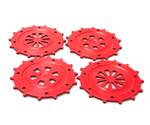Milacron Is First to Integrate iMFLUX into Machine Controller
Integrating iMFLUX low-pressure process into machine controls is a more economical route to faster cycles and improved part quality.
At last week’s Fakuma 2018 show in Germany, Milacron announced a first-of-its-kind agreement with iMFLUX, the new subsidiary of Procter & Gamble that developed a novel injection molding concept based on low and highly consistent injection pressure. Through this agreement, Milacron will integrate iMFLUX’s proprietary process-control software into its injection machines with native user interface and screens on its Mosaic controller. Milacron will be the first machine manufacturers to offer such integration, which eliminates the need for a separate iMFLUX control screen.
According to an iMFLUX representative at the show, significant cost savings are possible when iMFLUX is integrated into the machine when purchased. Milacron has certain exclusive rights to integration of iMFLUX process data with its controller. Milacron is adding iMFLUX as a software module within its M-Powered suite of IoT utilities. As previously reported, Milacron showed iMFLUX in action on an all-electric Elektron EVO 155 press, which is sold only in Europe. But Milacron says it will phase in iMFLUX capability for all its presses.
iMFLUX uses low but highly consistent pressure, allowing velocity to vary with the geometry of the part, to achieve up to 50% faster cycles with reduced part weight, lower stress, less warpage, and fewer sinks, as explained in a March ’18 feature article. Outfitting a machine for iMFLUX typically (but not always) requires a nozzle adapter with a pressure sensor, a CPU in the control cabinet to send signals to the machine controller, and special control software. Company sources say the process has been tested on machines from 20 to 5500 tons and on molds with up to 196 cavities.
Although iMFLUX offers relatively little speed advantage in very fast-cycle molding, it reportedly still offers quality benefits through improved balancing of high-cavitation molds. For that reason, the company is exploring cap and closure applications. iMFLUX has also done some experiments with the process in co-injection and gas-assist molding.
At Fakuma, iMFLUX showed a new enhancement in the form of automatic viscosity-adjustment software. It recognizes a change in melt viscosity and adjusts filling to maintain consistent low pressure. At the show, this capability was demonstrated by switching on the fly from molding a 20 MFI PP to 8 MFI PE and vice versa. In real life, iMFLUX sees this capability as assisting in the use of scrap or recycled materials, whose viscosity can be variable, especially when the proportion of reused materials may vary over time.
At the show, the Elektron press with iMFLUX molded the PP in a four-cavity test mold at 250 bar (3626 psi), much lower than the typical 545 bar (7905 psi) in conventional molding. The cycle time without iMFLUX was 24 sec, vs. 17 sec with iMFLUX. Molding the PE grade reportedly showed a similar 30% decrease in cycle time.
The versatility of the iMFLUX system was also demonstrated by blocking off three of the four cavities in the test mold by deactivating hot-runner valve gates. The controls automatically compensated, maintaining the same part weight with no flash.
Related Content
-
Best Methods of Molding Undercuts
Producing plastics parts with undercuts presents distinct challenges for molders.
-
How to Get Rid of Bubbles in Injection Molding
First find out if they are the result of trapped gas or a vacuum void. Then follow these steps to get rid of them.
-
How to Stop Flash
Flashing of a part can occur for several reasons—from variations in the process or material to tooling trouble.















